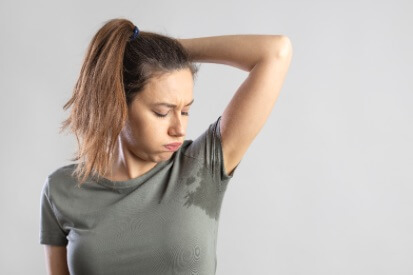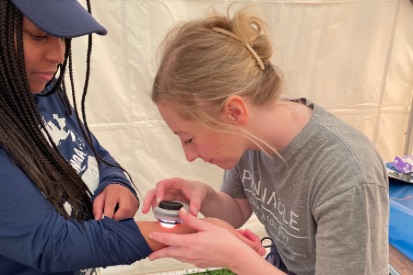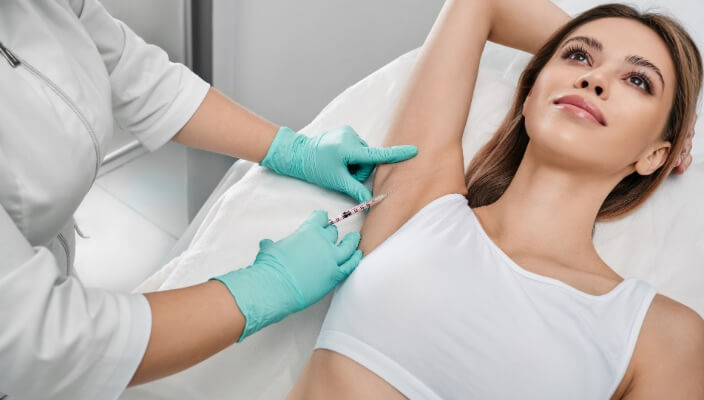Understanding Hyperhidrosis Treatment Results
 Are you struggling with excessive sweating and wondering how soon you can expect relief from hyperhidrosis treatments? Many individuals face this uncomfortable issue, often seeking solutions that fit their needs. In this article, we will discuss various treatment options, factors that influence the speed of relief, and insights from real-life experiences. By understanding these aspects, you will gain valuable information to help manage your condition effectively and address your concerns about timing, ultimately improving your comfort and confidence.
Are you struggling with excessive sweating and wondering how soon you can expect relief from hyperhidrosis treatments? Many individuals face this uncomfortable issue, often seeking solutions that fit their needs. In this article, we will discuss various treatment options, factors that influence the speed of relief, and insights from real-life experiences. By understanding these aspects, you will gain valuable information to help manage your condition effectively and address your concerns about timing, ultimately improving your comfort and confidence.
How Quickly Can I Expect Relief From Hyperhidrosis Treatments?
As we assess hyperhidrosis treatments at various location, understanding the timelines for relief is essential. This section will provide an overview of various approaches, such as laser surgery and targeted therapies that damage sweat glands, discussing the expected outcomes for each. We will also explore how these options influence sweat production in relation to other bodily functions, like urine output.
Overview of Hyperhidrosis Treatments and Their Timelines
There are several effective treatments for hyperhidrosis, each with varying timelines for relief. For instance, treatments such as botulinum toxin injections can show efficacy within days, with the effects lasting for several months. In contrast, laser therapy may require multiple sessions to achieve noticeable results, which can weigh on patients who seek immediate relief. A systematic review of available therapies highlights the importance of considering the associated risks and recovery times when selecting the best option for individual needs.
Excessive Sweating Can Be Controlled - Learn Ways Below!





Various Treatments and Their Expected Results
In this section, we will examine various treatments for hyperhidrosis and their timelines for relief. We'll discuss topical treatments like glycopyrronium bromide, which can yield noticeable changes quickly. Next, we'll explore oral medications, including their effectiveness relative to the nervous system, followed by fast-acting antiperspirants. Botulinum toxin injections will be addressed, focusing on their timeline, and we'll conclude with surgical options and their recovery periods. Each method offers unique advantages and expectations, allowing us to identify the most suitable approach for managing moisture control.
Topical Treatments: How Soon Will You Notice Changes?
Topical treatments for hyperhidrosis can provide noticeable changes within a few days of application. For example, formulations containing glycopyrronium bromide effectively reduce sweat production while minimizing issues like dehydration and irritation. Patients seeking quick relief from symptoms often find these options advantageous in managing their moisture levels, especially during stressful situations or before exposure to heat or radiation:
- Topical treatments typically act within days.
- Glycopyrronium bromide is a popular option.
- Common side effects may include irritation or discomfort.
Oral Medications: When Do Results Start to Show?
Oral medications for hyperhidrosis, such as oxybutynin and beta blockers, generally require a few weeks to show their full effects. While these medications can help manage excessive sweating, especially in patients experiencing symptoms related to menopause or anxiety, we must be mindful of potential side effects like dry mouth and dizziness. It's crucial to consult a healthcare professional before starting any treatment, particularly if there are existing conditions such as hypertension, as some medications may exacerbate these issues or interact with others like aluminium chloride used in topical applications.
Antiperspirant Options: Fast-Acting Formulas Explained
When considering fast-acting antiperspirant options for hyperhidrosis, we can appreciate the effectiveness of formulations that incorporate active ingredients like aluminum compounds. These antiperspirants work by temporarily blocking sweat glands and can provide relief within a few hours. It's essential to note that while these products may offer quick results, individuals with conditions such as type 2 diabetes should be cautious and consult a healthcare professional beforehand to avoid potential interactions with medications, including certain antidepressants and local anesthetics. Furthermore, maintaining adequate levels of vitamins and calcium may also support overall skin health, which can complement antiperspirant use in managing excessive sweating.
Botulinum Toxin Injections: Timeline for Effectiveness
Botulinum toxin injections provide a reliable option for individuals seeking relief from hyperhidrosis, typically showing effects within 3 to 14 days after treatment. These injections work by blocking signals from the nerves that trigger sweat glands, significantly reducing sweat production in targeted areas. While the duration of effectiveness may vary, most patients experience relief lasting several months before requiring a follow-up treatment. It is important for those considering injections to consult with health care professionals to discuss their specific needs and any potential interactions with other treatments such as anticholinergic medications or clonidine.
- Botulinum toxin injections show effectiveness in 3 to 14 days.
- They block neurological signals that lead to sweating.
- Patients typically enjoy relief for several months.
- Consulting a health care professional is essential for personalized advice.
Surgical Options: Recovery Time and Initial Outcomes
Surgical options for hyperhidrosis, such as sympathectomy, offer a more permanent solution, but they require careful consideration of recovery time and potential outcomes. Typically, patients can expect a recovery period of several weeks, during which they may experience itchiness or other discomfort as their bodies adjust after the procedure. It's important to discuss your medical history and body mass index with your healthcare provider, as these factors can influence your sympathetic nervous system’s response to surgery and the overall effectiveness of the treatment.
Factors Influencing the Speed of Relief
Individual variability in treatment response can significantly influence the timeline for relief from hyperhidrosis. The severity of this condition also plays a crucial role, affecting how quickly results can be noted. Consistency in applying treatments, such as botox injections, is essential for optimal outcomes. Additionally, professional guidance helps determine the best timing for interventions, considering factors like energy levels, ganglion involvement, and at times, the risk of bleeding during procedures.
Individual Variability in Treatment Response
When considering the speed of relief from hyperhidrosis treatments, we recognize that individual variability plays a significant role. Factors such as genetics can influence how one's body responds to various therapies, meaning that while some may experience swift results, others might encounter delays or different side effects like fatigue or nausea. Understanding these differences emphasizes the importance of personalized pain management strategies and ongoing communication with healthcare professionals to ensure treatment plans align with individual needs and responses.
Severity of Hyperhidrosis and Its Impact on Results
The severity of hyperhidrosis significantly influences the effectiveness and timeline for achieving relief from treatments. Patients with mild cases may experience quicker results from topical solutions or antiperspirants, while those with more severe symptoms may require more intensive interventions, such as botulinum toxin injections or surgical options affecting the sympathetic trunk. For instance, in a randomized controlled trial focusing on treatment outcomes, participants with severe hyperhidrosis often reported a longer adjustment period before noticing substantial changes, illustrating the importance of personalized treatment plans based on individual severity levels:
- Severity impacts response time to treatments.
- Mild cases benefit from topical solutions.
- Severe cases may need more intensive options.
- Understanding individual needs aids in effective treatment.
Consistency in Treatment Application and Usage
Consistency in treatment application and usage plays a pivotal role in achieving optimal relief from hyperhidrosis. By adhering to a routine that includes topical treatments or medications, we can influence sweat production more effectively. Moreover, integrating a healthy diet and maintaining proper fluid intake support overall skin health, which may enhance treatment outcomes. Observing any interconnections with alternative medicine practices may also yield insights into improving the efficiency of hyperhidrosis management, as epidemiology suggests that lifestyle factors can significantly affect individual responses to therapy.
Professional Guidance: Considerations for Optimal Timing
Seeking professional guidance is essential for determining the optimal timing of hyperhidrosis treatments. This support helps us navigate various factors, such as medications that may influence sweating and conditions like xerostomia, which can lead to discomfort. By closely monitoring our body’s responses, including potential weakness or changes in bladder function, healthcare providers can tailor a treatment plan that enhances the effectiveness of gland-targeting therapies.
- Professional evaluation helps establish treatment timing.
- Monitoring for side effects like xerostomia and weakness is crucial.
- Understanding bladder health can inform treatment decisions.
- Adjusting medication based on individual responses enhances outcomes.
Differences in Outcomes Based on Treatment Type
When we evaluate the differences in outcomes based on treatment type for hyperhidrosis, we often see significant variations in patient experiences. For instance, patients undergoing botulinum toxin injections usually report rapid relief within a week, effectively reducing sweating with minimal side effects like mood fluctuations or increased heart rate. In contrast, those opting for oral medications may take several weeks to notice improvements, sometimes experiencing adverse effects such as vomiting, which can hinder their motivation to continue treatment. Understanding these nuances allows us to set realistic expectations and choose appropriate therapies for optimal management of hyperhidrosis.
Questions to Ask Your Doctor About Treatment Timelines
When discussing treatment timelines for hyperhidrosis, we should focus on key inquiries for a productive consultation. Questions regarding the potential need for follow-up appointments and adjustments, as well as understanding side effects that may affect results, are vital. These discussions can help clarify expectations surrounding treatments such as sympathectomy and toxin injections while considering impacts on physical activity and potential scarring.
Key Inquiries for a Productive Consultation
When preparing for a consultation about hyperhidrosis treatments, we should focus on specific questions that can provide clarity and direction. For example, it may be beneficial to inquire about the impact of specific deodorants on sweat production or how hormonal changes, such as those occurring during breastfeeding, might influence treatment effectiveness. Understanding how skin conditions, including those related to tissue health or concerns about skin cancer, could interact with treatment options will also allow us to make informed decisions about our care:
- What are the expected timelines for relief based on my specific condition?
- How might deodorants interact with the treatments I'm considering?
- Can hormonal changes or breastfeeding impact the effectiveness of the treatments?
- What precautions should I take regarding tissue and skin health during treatment?
- Are there any concerns about skin cancer that we should address before starting treatment?
Expecting Follow-Up Appointments and Adjustments
During our consultations about hyperhidrosis treatments, it’s essential to discuss the potential need for follow-up appointments and adjustments. Understanding that procedures such as endoscopic thoracic sympathectomy may require careful monitoring for side effects is vital. This approach can help us assess any changes in appetite or other unexpected reactions, ensuring we stay on track for relief while making necessary modifications to the treatment plan as needed.
Understanding Side Effects That May Affect Results
When exploring treatment options for hyperhidrosis, it's essential to understand the side effects that may impact results. For instance, individuals might experience confusion or memory issues, particularly with medications that influence the central nervous system. Furthermore, treatments may lead to concerns such as hair loss or symptoms consistent with an overactive bladder, which can complicate the overall management of hyperhidrosis.
- Discuss potential side effects, such as confusion and memory issues.
- Inquire about the risk of hair loss with certain treatments.
- Ask how medications may affect symptoms of overactive bladder.
Lifestyle Adjustments to Enhance Treatment Efficacy
Daily habits that support treatment outcomes are vital for effectively managing hyperhidrosis. We will discuss lifestyle adjustments that can minimize perspiration, such as diet and exercise routines, including abdominal workouts that promote overall health. Staying informed about the latest treatment options ensures we are utilizing the most effective methods. Additionally, we will emphasize the importance of having a support network for emotional relief, which can enhance overall well-being during the treatment process.
Daily Habits That Support Treatment Outcomes
Adopting daily habits that foster positive treatment outcomes for hyperhidrosis can greatly enhance relief timelines. Incorporating regular physical activity, such as abdominal workouts, supports overall health and helps optimize the body’s response to treatments, while maintaining hydration can aid in managing excessive sweating. Additionally, exploring complementary approaches like acupuncture may provide added benefits by potentially increasing serotonin levels and alleviating some of the stress that can exacerbate symptoms, making it easier to manage this challenging disease.
Staying Informed About Latest Treatment Options
Staying informed about the latest treatment options for hyperhidrosis is essential for achieving the best outcomes. Understanding how primary interventions can influence thermoregulation may lead to improved comfort and reduced sweating. We recognize that being aware of potential adverse events, such as skin irritation from chloride-based products, allows us to make informed decisions that align with our needs and enhance our overall treatment experience.
Emphasizing a Support Network for Emotional Relief
Having a strong support network can significantly enhance our emotional relief while undergoing treatments for hyperhidrosis. Engaging with supportive family members, friends, or online communities can help us navigate the mental challenges posed by excessive sweating, improving our quality of life. For example, discussing our experiences openly can provide comfort and reduce feelings of isolation, especially when exploring options like ultrasound therapies or managing common concerns, such as injury or discomfort in the stomach area.
- Building a network improves emotional well-being.
- Sharing experiences fosters a sense of community.
- Open communication enhances comfort with treatment options.
- Support can alleviate feelings of isolation.
- Discussing concerns like injury or discomfort can provide reassurance.

Schedule An Appointment & Relieve Your Excessive Sweating
Find a location nearest you and schedule online today.
Featured Blogs

- General Dermatology
- Cosmetic Treatments
There’s nothing discrete about excessive armpit sweating. And with the obvious wet or sweat-stained clothing and worrisome body odor, it’s easy to feel uncomfortable, frustrated, and embarrassed.
Read More
- Cosmetic Treatments
Living with embarrassing underarm sweat stains? miraDry® is a simple, safe, and non-invasive cosmetic procedure that permanently eliminates underarm sweat glands for good.
Read More
- General Dermatology
While sweating, our body’s natural cooling system helps regulate our internal temperature, too much of a good thing can lead to serious skin issues.
Read More


